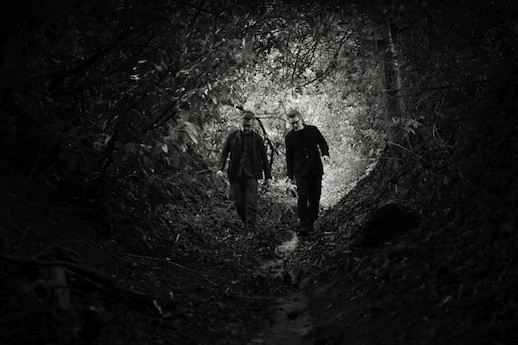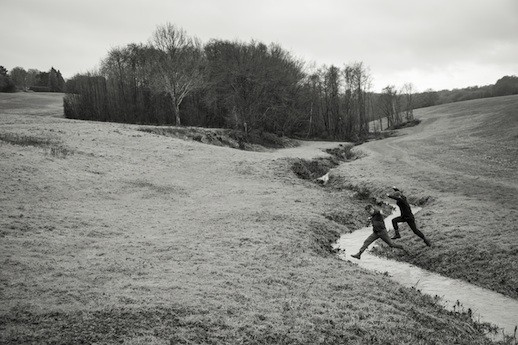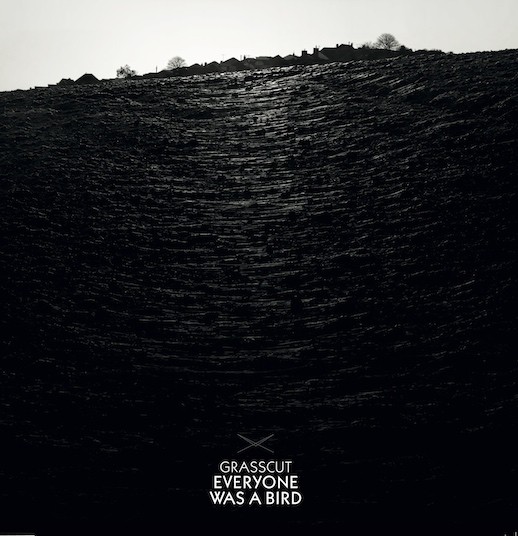
Robert Macfarlane’s liner notes to Everyone Was A Bird, the new LP from Grasscut. Published with permission.
‘It is the nature / Of the world / It is as dark as radar’, wrote the American poet George Oppen in 1963. As dark as radar? What could Oppen have meant by that, you wonder at first. Slowly, though, the image resolves: operators hunched over their screens, distant objects returning faint signals, the confusions of clutter, pure darkness beyond the blips of light…. This, you realize, is our experience of the world’s ‘nature’: tiny pulses of knowledge, set in a vastness of shadow.
Oppen’s poem lends a lyric to the second track of this eerie and beautiful album, and versions of his ‘radar’ vision play through the whole. Glimpsed dreams, fugitive memories, and landscape apparitions are its preoccupations; decay, flight and radioactivity its motifs. Again and again come images of light beset by dark: ‘glittering estuary mud’ at dusk in ‘Curlews’, sun ‘pooling upon the channel’ beneath black clouds in ‘Islander’, ‘headlights through the trees’ in ‘Radar’. The album longs for ‘illumination’ ¬– fiat lux! – and finds it now and then, here and there (in a shooting star, the cries of curlews, the feel upon the human body of warm granite, then cold sea-water). But all understanding is provisional, all sight is partial, and the dark will come flooding back in soon enough: ‘white white light edges to black’ (‘Fallswater’).
The soundscape is richly textured with these ideas. You’ll know a little of what to expect if you’ve heard Grasscut’s earlier albums; if not, you’ll find your way onwards and into the strange terrain here soon enough. Spectral electronica, the alarm-bleeps of equipment on overheat, sampled voices speaking through static, the crackle of dust on the phonograph needle, the fizz and buzz of interference. Utterances ebb and fade. Lyrics pass in and out of audibility. The sense is of turning a wireless tuning dial, without ever quite finding a frequency. When ‘dead voices speak through the living voice’, wrote T S Eliot in 1919, defending quotation and allusion as poetic techniques, the result can be intensely powerful: not just ‘re-creation’, but even ‘re-incarnation’. ‘Saturation’, continued Eliot, ‘combusts spontaneously into originality’.
Something like saturation, and something like combustion, happens here. The record is densely referential. And what a mixture of people it gives voice to: from experimental poets (George Oppen, Ed Dorn) to the architect of Coventry Cathedral and Trawsfynydd nuclear power station (Sir Basil Spence), from Hilaire Belloc through to Siegfried Sassoon, in the poem that provides the album with its title. ‘O But Everyone / Was a bird, wrote Sassoon in his account of the announcement of the Armistice on 11 November, 1918. The Armistice’s signing led to singing: the men of Sassoon’s regiment, the Welch Fusiliers, broke into songs of celebration, and the joyful surge of feeling in those raised voices is unforgettably caught in the poem:
Everyone’s voice was suddenly lifted;
And beauty came like the setting sun:
My heart was shaken with tears; and horror
Drifted away… O but Everyone
Was a bird; and the song was wordless; the singing will never be done.
That movement ¬– that sudden lift from earth to air, that becoming-bird – happens in almost every track. A keyboard rush, a pickup of beats, a swoop or stoop of strings and you feel for a few seconds airborne, hawk-sighted, gorgeously aloft. Briefly and beautifully you ‘float out’ and ‘dive down’ (‘Islander’), you are the ‘sparks that fly’ (‘Radar’), you are the ‘sing sing sing of the spray’ that the waterfall flings (‘Fallswater’), or you are the curved high call of the curlews as they beat upriver from the estuary on their big wings. Listening, I thought often of the Wart in T H White’s The Sword In The Stone, who is transformed variously into a hawk, a goose, an owl. Each of his transformations brings him a new ability, new knowledge. As White relies on an abstract language to describe the sensations of flight – the air is ‘a pulseless world-stream steady in limbo’; Wart-as-goose feels like ‘a point in geometry, existing mysteriously on the shortest distance between two points’ ¬– so Grasscut use the inarticulacy of music to catch the sensation of being in what White calls ‘the enormous flatness of the sky’.
These flight-moments are strong dreams, quick light-gleams, and their presence is both rebuke and acceptance of the ghosts and bleak forgettings that also populate the album. ‘Halflife’ is the most haunted of all the tracks here. The ‘he’ of the lyric is the Welsh poet Hedd Wyn, who like Sassoon joined the Royal Welch Fusiliers, who was killed at Passchendaele on the last day of July 1917, and who had been born and brought up near the village of Trawsfynydd ¬– which in 1959 became the site of a twin-reactor Magnox nuclear power station. Anyone who has been to Trawsfynydd will know the huge cognitive dissonance of the area: out on the island in the lake stands the decaying concrete castle, with its lethal treasure still inside, while above and behind it rear the Rhinog mountains, wild and catastrophic.
‘Halflife’ imagines Wynn as a post-nuclear apparition trapped in an 8mm film-loop by the shores of the lake: ‘a loop he makes / through silver birches flickering / by concrete towers he disappears / disappears’. It’s a track that works its way under the mind’s skin. It flickers itself, moving in and out of clarity. The language of decommissioning and unknown futures haunt it, and fragments of the past fly through it ¬– like the ‘shells by the roadside’ which recall the nosecap shell that struck Wynn in the stomach as he crossed the Pilckem Ridge advancing on the Iron Cross stronghold. ‘I saw him fall’, remembered a fellow Fusilier, ‘I saw him fall on his knees and grab two fistfuls of dirt. He was dying, of course.’
The fistfuls of dirt that Wynn grasps in his death-pangs recall the action of another Welsh war poet, Edward Thomas. When asked shortly after enlisting by his friend Eleanor Farjeon if he knew what he was fighting for, Thomas bent down and picked up a handful of earth. Crumbling it between his fingers, he replied ‘Literally, for this.’ That earth was fatal for Thomas, too – he would be killed by shell-fall on the first day of the Battle of Arras in April 1917, four months before Wynn. But while he lived, Thomas was one of the finest early-century writers of landscape and its stories, and of how those stories might be walked up and listened in to. Thomas’s influence can be felt throughout this album, and especially in the late track ‘The Field’, which features a walker-figure, out on foot early one winter morning, kept company by a double or ghost (‘the one who walks beside you’), and following a chalk path along the verge of ‘a fallow field’.
‘All of the lyrics and the time-signatures have come while running or walking’, Andrew Phillips told me. Everyone Was A Bird is an album ‘born of footfall’. Each track corresponds to a particular place, and each carries a record of ‘the steps that the place demanded’: a topographic tempo, as it were. The locations range from the island of Jersey, to the South Downs, to the mountains and estuaries of Wales. The question of ‘nation’ is almost an irrelevance; far more active are the Welsh concepts of cynefin (the heartland of one’s childhood), hiraeth (one’s yearning for a place of belonging, in which one might dwell) and ardal (a place one has come to love through experience) All three forms of place-attachment can be heard and felt here. Phillips is a man of marginal territories and mixed heritage: born to a Welsh mother and a half-Welsh father; raised on Jersey (an island nine miles from France, in which a form of Norman is still spoken); and living for years on the chalk of Southern England. ‘“Belonging” is a case of where you take your sky from’, Phillips has said. His music registers this complex geography, and those who might characterize Grasscut’s sound as ‘quintessentially English’ or otherwise Albionish, are far wide of the mark: there is no mid-century nostalgia at work, no Keep-Calm-And-Carry-On kitsch.
Everyone Was A Bird ends with a track called ‘Red Kite’. Its landscape is post-pastoral, beautiful and messed-up at once; the folky string-stutter that opens it catches at this intertwining. Then comes a scratchy sample of Sassoon reading from his Armistice poem, and then two figures of the song ‘follow the hillside’ up through ‘stone piles’ to a ‘copper mine’, through ‘slate dumps’ up to the ‘snow line’. Altitude brings vision of a kind: the view is of ‘concrete towers and power lines’, overflown by red kites and skylarks. The strings build and lift over several minutes, sight is further granted, the snow gleams and tingles, and the spirit soars. Then Sassoon returns, murmuring his poem’s paradoxical refrain: ‘the song was wordless’. And at that prompt, of a sudden, the sound is snatched away as if sucked into a vacuum, the album ends ¬– and the world is once again as dark as radar.
Robert Macfarlane, Cambridge, 2015
Everyone Is A Bird is released in May on Lo Recordings. Their current single, Curlews, can be listened to here.
Grasscut and Robert Macfarlane will be performing live at the Caught by the River Faber Social event on Monday 13 April.

